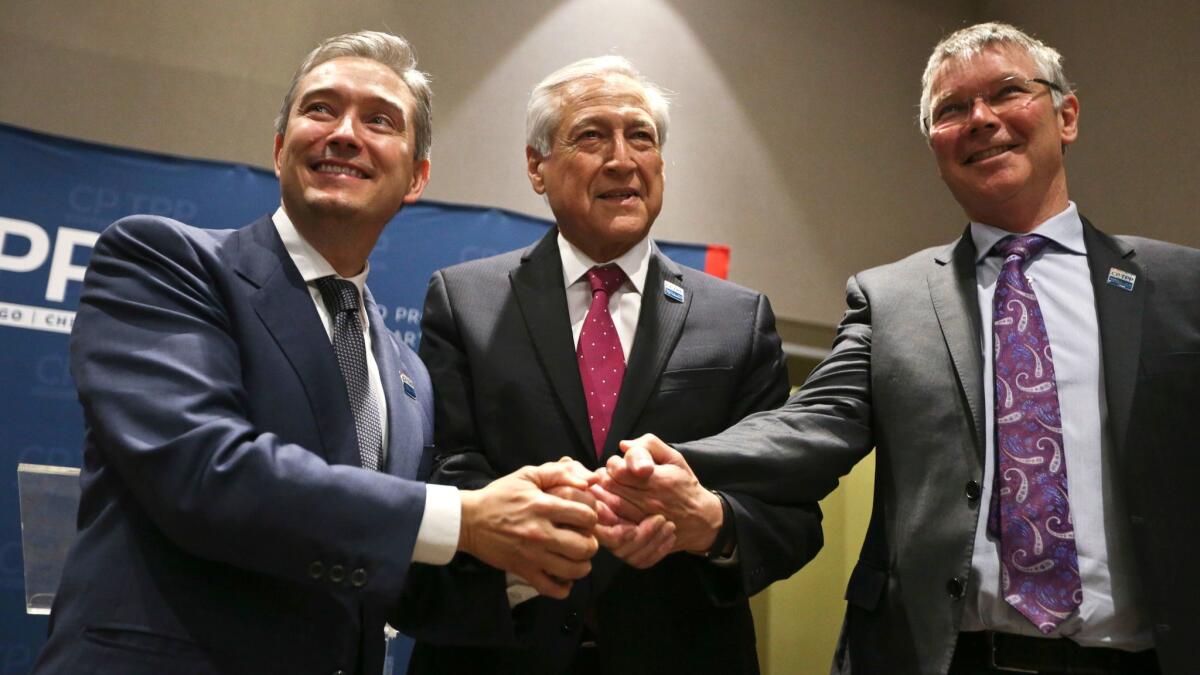11 nations sign Pacific free trade agreement, not including U.S.

Trade ministers from 11 Pacific Rim countries signed a sweeping free trade agreement Thursday to streamline trade and slash tariffs just hours before President Trump announced his plans to impose new tariffs on aluminum and steel to protect U.S. producers.
Trump withdrew the U.S. from the Trans-Pacific Partnership last year, causing fears that it would not prosper without its most influential country. But the remaining 11 members pressed ahead, saying they were showing resolve against protectionism.
The ministers dropped key provisions that the Americans had required on protection of intellectual property, among others. The renegotiated pact signed in the Chilean capital of Santiago was renamed the Comprehensive and Progressive Trans-Pacific Partnership.
The pact covers 500 million people; it includes Australia, Brunei, Canada, Chile, Japan, Malaysia, Mexico, New Zealand, Peru, Singapore and Vietnam, which together account for 13% of the global economy. Its success highlights the isolation of the U.S. under Trump’s protectionist rhetoric on trade and his “America first” philosophy.
“It leaves the U.S. at a disadvantage from both a trade and a broader strategic perspective,” said Joshua Meltzer, senior fellow in the global economy and development program at the Brookings Institution. “It is now a trade bloc that discriminates against the U.S.”
Meltzer said the United States’ ability to shape the rules of trade in the Asia-Pacific region “is very much diminished.”
The U.S., originally the biggest TPP economy, was one of the trade deal’s strongest supporters before Trump took office. Trump has said he prefers country-to-country deals and is seeking to renegotiate several major trade agreements, including the North American Free Trade Agreement that includes the U.S., Mexico and Canada.
This is “a strong sign against the protectionist pressures, and in favor of a world open to free trade, without unilateral sanctions and the threat of trade wars,” Chilean Foreign Minister Heraldo Munoz said.
The European Union said this week that it is ready to retaliate against Trump’s tariffs — of 25% on imported steel and 10% on aluminum imports — with counter-measures against such U.S. products as Harley Davidson motorcycles, Levi’s jeans and bourbon.
The EU threat and Trump’s announcement on the tariffs were expected to escalate the risk of a trade war, in which nations try to punish each other by hiking taxes on traded goods. Experts say that tends to harm both exporting nations as well as consumers in importing countries, who face higher costs.
The EU considers itself to be caught in the crossfire of a trade dispute, in which Trump has mainly singled out China for being unfair in its commercial deals.
The original TPP was conceived by the U.S. as a counterweight to China’s growing economic influence through a robust trading bloc that excluded the Asian giant. The thinking was that China would have an incentive to open its market and liberalize its policies in an effort to eventually qualify for TPP membership.
“Without the United States, it doesn’t serve that purpose,” said Edward Alden, senior fellow at the Council on Foreign Relations. “It becomes a modest liberalization measure.”
China’s foreign minister, Wang Yi, commented Thursday on the deal before it was signed.
“China did not participate in the CPTPP Agreement. However, China has always been a staunch supporter of trade liberalization and an important participant in Asia-Pacific regional cooperation and economic integration,” Wang said at a news conference.
“Of course, we also hope that the various free trade arrangements in the Asia-Pacific region will be able to communicate and coordinate with each other and form a benign interaction, playing a constructive role in their respective fields in resisting trade protectionism and building an open world economy.”
UPDATES:
1:40 p.m.: This article was updated with Trump’s announcement, information about the countries in the deal, about trade with China and comments from Edward Alden and Wang Yi.
This article was originally published at 11:20 a.m.
More to Read
Inside the business of entertainment
The Wide Shot brings you news, analysis and insights on everything from streaming wars to production — and what it all means for the future.
You may occasionally receive promotional content from the Los Angeles Times.










